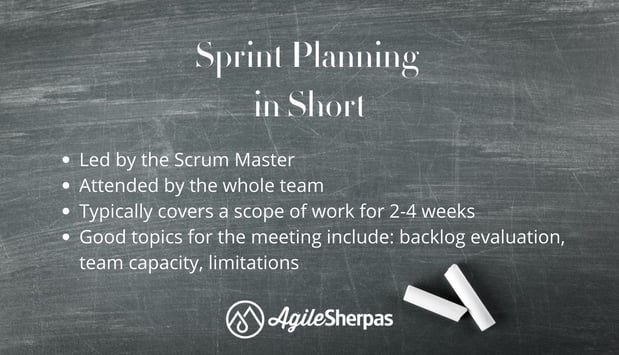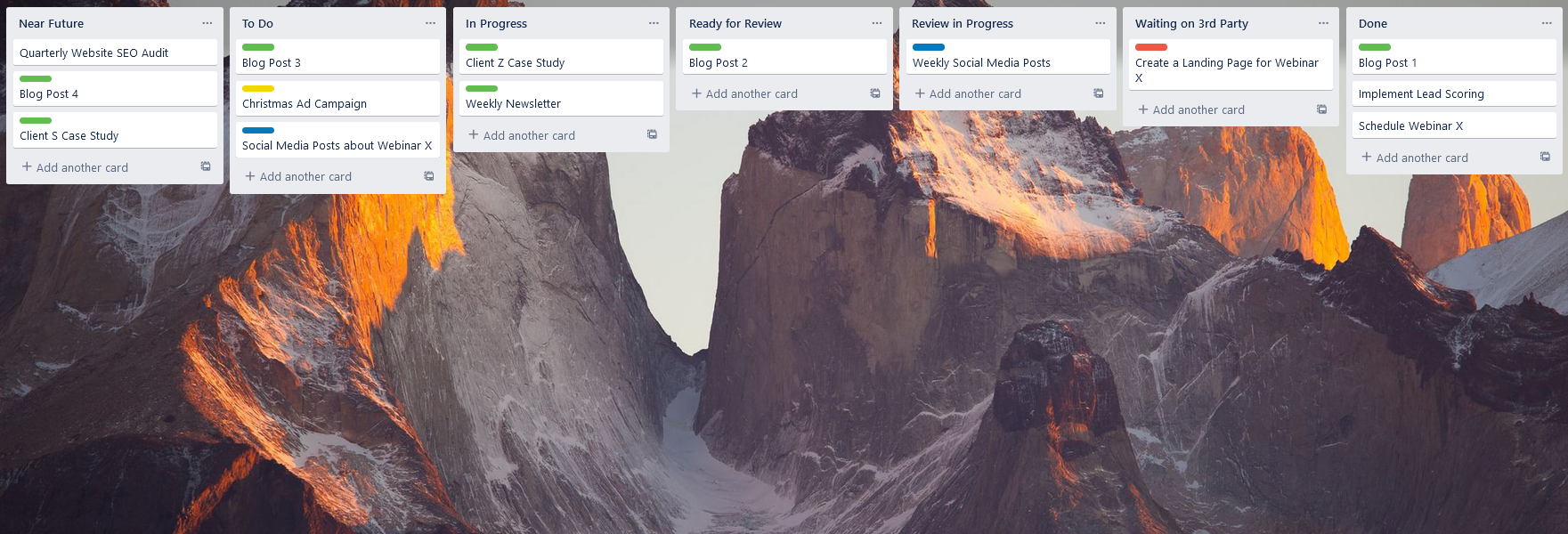Improve your Marketing Ops every week
Subscribe to our blog to get insights sent directly to your inbox.
Confront your process problems head on with a Sherpa by your side.
Explore support options that are tailored to meet you wherever you are on your climb.
Learn from the stories of marketers already on the road to process improvement.
Featured Resource

State of Agile Marketing
Learn from 8 years of study on how marketers are increasing their agility.
Download Report
As Agile adoption for marketing work continues to rise, many patterns are emerging in the way marketers approach Agile process management.
One of the most compelling patterns is that marketers don't like limiting themselves to a single method for applying Agile.
On the contrary, more than half of marketers have adopted a unique approach to Agile, combining various practices from Scrum, Kanban, Lean, and other frameworks to gain an edge and improve the way they work.
With so many Agile practices available, marketers face many decisions as they craft their hybrid framework.
So, which practices are marketers leaning on the most to get the best out of their teams?
The 7th Annual State of Agile Marketing report provided us with valuable insights about how, when, and why marketers go Agile.
Most of all, this year's report gave us a glimpse into the exact Agile practices that marketers have been relying on to get them through an incredibly challenging year (and beyond).
Here are the top five Agile practices that marketers swear by, according to our latest research.
The sprint planning ceremony proved itself as one of the most popular Agile practices among marketers.
This Agile meeting is led by the scrum master and attended by the core Agile team before the sprint kicks off. During sprint planning, the team evaluates the backlog (previously prioritized by the marketing owner) and commits a chunk of work to get done within the sprint. Most Agile teams set their sprints to last 2-4 weeks.

This time represents the team’s opportunity to talk about capacity, limitations, and out-of-office plans that may affect capacity.
The scrum master should use the team’s historical velocity to make sure that the team is making realistic promises about what they can accomplish within the sprint.
During this period of time, the team only focuses on completing the work they committed to during sprint planning. If any other work comes in, or if something unplanned changes the priorities, the conversation centers around what gets taken out of the sprint.
This is a huge shift for marketing teams that typically just say yes to everything and rely on their own heroic after-hours efforts to get it done.
Structured sprints can be a powerful tool to make sure that a team has a clear focus on what needs to be done and drown out any unnecessary distractions.
It’s no wonder that 49% of marketers use it to help them plan and stay on track.

A close second in popularity to sprint planning is the daily standup.
Fifty seven percent of respondents to the State of Agile Marketing report identified this meeting as a key practice their teams are using to be successful.
The daily standup is a brief Agile sync that occurs each day with the team for approximately 15 minutes. It represents an opportunity for a short-term strategy huddle that makes sure the team maintains daily communication throughout the sprint.
The scrum master acts as the ringleader in this meeting. It’s their responsibility to keep everyone on task and within the 15-minute timebox for the meeting.
Everyone on the Agile team attends and provides a short-term plan for the day.
This isn't a meeting for everyone to explain every detail of their work, or show off how busy they are. The recommended format for this meeting is:
These three questions get to the crux of what is most important to keep things moving towards completion.
If any blockers are mentioned, the scrum master or the team should work together to unblock that work.
Any further questions or follow up should be taken offline or sorted through after the meeting.
As a testament to the importance of Agile meetings in marketers' hybrid approach to Agile, sprint reviews are quickly becoming one of the more popular Agile practice among marketers. This year 33% of marketers are hosting them on a regular basis.
Who doesn’t love a good show and tell? The sprint review is the Agile meeting during which the core team presents completed projects that were launched or put into market over the course of the last sprint.
Teams present their finished campaign/product along with any metrics, data, or findings they've collected to report on how it performed.
Anyone outside of the core team who is interested in catching up with the progress of the team can attend this meeting, because it is considered an "open invitation" meeting.
If a particular campaign performed really well, attendees may want to replicate some pieces in their own work. Alternatively, if something didn't do well, there's value in sharing learnings to make sure that the teams can all avoid that mistake in future efforts.
In this case, as in many others, the campaigns and materials shared in sprint/iteration review impact future team backlog items.
If the pandemic has taught us anything about remote work, it’s that having the right tools in place for project management and collaboration is key to keeping things moving.
There are MANY digital project management tools out in the world in this day and age. If that's the case, then what's the difference between a traditional Gantt chart or traditional project management tool and a Kanban board?
Kanban boards allow visibility into the current realities of a workflow.
Unlike Gantt charts, which only showcase when work ought to be started and worked on, a Kanban board allows everyone to see which projects are being worked on and what stage of production they're currently in.

They're also a great tool to determine who is, or will be, assigned to a project, and to define whether a project is blocked in the workflow.
In the digital version of a Kanban board, team members are able to add attachments, comment to one another, write notes, and even approve work using detailed Kanban cards.
According to our findings, 45% of Agile marketers are currently using a Kanban board to map their work visually.
Given the pace at which this practice is gaining traction among marketers, it seems like soon this method of task management might finally put an end to back and forth email threads and anxiety about document version control.
Customer-focused work is at the heart of any implementation of agility.
Agile values and principles dictate that, if our teams want to reach high performance, then all of the work that we produce should be for the benefit of the customer.
Customer-centric campaigns are the best performing campaigns, but many marketers tend to fall back into talking about our products and services.
User Stories are an Agile planning tool that helps bridge the gap between what our customer wants and the goals of the marketer who has the skills to build a solution. (Note: customers can be internal or external depending on your role.)
Based on the latest research, 39% of Agile marketers rely on this technique to keep customer focus top of mind inside the business.
The three components of a user story aim to create a shared understanding of the customer goal among team members involved in execution inside the organization.
Good user stories begin with a clear persona, state the need of that persona, and end with the value an appropriate solution would bring.
The most common format of a user story is:
As a ____ I would like ____ so I can____.
Good user stories avoid prescribing a specific solution to the execution team, avoiding the disadvantages of micromanaging.
Instead, they provide the team with the information they need to ideate around a solution that they can contribute. In the hands of an Agile team, an effective user story can provide the context necessary to brainstorm the best solutions to solve the problem and provide the value the customer needs.
The Agile practices that are currently enjoying the highest levels of popularity inside marketing indicate that marketers are taking their Agile meetings, customer centricity, and visual workflows very seriously.
These three pillars of Agile represent where the most marketers have made significant headway in their adoption of Agile methodology.
However, even though these are the most popular, they're not the only practices marketing teams are using to improve their process.
What other practices are marketers using in their Agile implementations? What are the up-and-coming Agile practices among marketers? The least popular practices?
Find answer to all of these questions and more in the 7th Annual State of Agile Marketing report .
If you are curious to see the whole picture of how, when and why marketers are going Agile, download the full version of the report for free today!

As a dedicated Agile trainer and coach, Colleen Dunn excels in bringing people together through Agile frameworks and giving them the tools they need to evolve into high-performing teams.
Subscribe to our blog to get insights sent directly to your inbox.
Subscribe to our blog to get insights sent directly to your inbox.